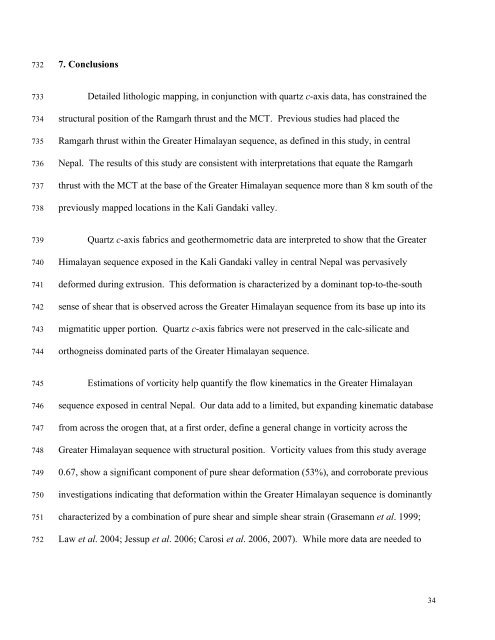Kinematics of the Greater Himalayan sequence, Dhaulagiri Himal ...
Kinematics of the Greater Himalayan sequence, Dhaulagiri Himal ...
Kinematics of the Greater Himalayan sequence, Dhaulagiri Himal ...
You also want an ePaper? Increase the reach of your titles
YUMPU automatically turns print PDFs into web optimized ePapers that Google loves.
732<br />
7. Conclusions<br />
733<br />
734<br />
735<br />
736<br />
737<br />
738<br />
Detailed lithologic mapping, in conjunction with quartz c-axis data, has constrained <strong>the</strong><br />
structural position <strong>of</strong> <strong>the</strong> Ramgarh thrust and <strong>the</strong> MCT. Previous studies had placed <strong>the</strong><br />
Ramgarh thrust within <strong>the</strong> <strong>Greater</strong> <strong><strong>Himal</strong>ayan</strong> <strong>sequence</strong>, as defined in this study, in central<br />
Nepal. The results <strong>of</strong> this study are consistent with interpretations that equate <strong>the</strong> Ramgarh<br />
thrust with <strong>the</strong> MCT at <strong>the</strong> base <strong>of</strong> <strong>the</strong> <strong>Greater</strong> <strong><strong>Himal</strong>ayan</strong> <strong>sequence</strong> more than 8 km south <strong>of</strong> <strong>the</strong><br />
previously mapped locations in <strong>the</strong> Kali Gandaki valley.<br />
739<br />
740<br />
741<br />
742<br />
743<br />
744<br />
Quartz c-axis fabrics and geo<strong>the</strong>rmometric data are interpreted to show that <strong>the</strong> <strong>Greater</strong><br />
<strong><strong>Himal</strong>ayan</strong> <strong>sequence</strong> exposed in <strong>the</strong> Kali Gandaki valley in central Nepal was pervasively<br />
deformed during extrusion. This deformation is characterized by a dominant top-to-<strong>the</strong>-south<br />
sense <strong>of</strong> shear that is observed across <strong>the</strong> <strong>Greater</strong> <strong><strong>Himal</strong>ayan</strong> <strong>sequence</strong> from its base up into its<br />
migmatitic upper portion. Quartz c-axis fabrics were not preserved in <strong>the</strong> calc-silicate and<br />
orthogneiss dominated parts <strong>of</strong> <strong>the</strong> <strong>Greater</strong> <strong><strong>Himal</strong>ayan</strong> <strong>sequence</strong>.<br />
745<br />
746<br />
747<br />
748<br />
749<br />
750<br />
751<br />
752<br />
Estimations <strong>of</strong> vorticity help quantify <strong>the</strong> flow kinematics in <strong>the</strong> <strong>Greater</strong> <strong><strong>Himal</strong>ayan</strong><br />
<strong>sequence</strong> exposed in central Nepal. Our data add to a limited, but expanding kinematic database<br />
from across <strong>the</strong> orogen that, at a first order, define a general change in vorticity across <strong>the</strong><br />
<strong>Greater</strong> <strong><strong>Himal</strong>ayan</strong> <strong>sequence</strong> with structural position. Vorticity values from this study average<br />
0.67, show a significant component <strong>of</strong> pure shear deformation (53%), and corroborate previous<br />
investigations indicating that deformation within <strong>the</strong> <strong>Greater</strong> <strong><strong>Himal</strong>ayan</strong> <strong>sequence</strong> is dominantly<br />
characterized by a combination <strong>of</strong> pure shear and simple shear strain (Grasemann et al. 1999;<br />
Law et al. 2004; Jessup et al. 2006; Carosi et al. 2006, 2007). While more data are needed to<br />
34

















